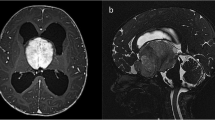Abstract
Purpose
Central nervous system tumors account for the largest number of cancer deaths in childhood. Brain tumors in infants less than 3 years of age are rare; symptoms and signs are often non-specific. Patent anterior fontanelles/unfused cranial sutures in infants can accommodate rising intracranial pressure without acutely compromising the neurological status. We hypothesize that vomiting as the initial symptom, in infants with brain tumors, can possibly lead to extensive gastrointestinal evaluation, delaying the diagnosis of intracranial pathology.
Methods
We conducted a retrospective chart review of infants less than 3 years of age diagnosed with brain tumors over the period of 4.7 years from February 2008 to October 2012 at Inova Children’s Hospital, Virginia.
Results
We identified three of 21 patients (14.3 %) who presented with vomiting and underwent initial or extensive abdominal imaging investigations. All patients were relatively young (median age, 5.4 months). Working diagnoses were pyloric stenosis, viral gastritis, or gastroesophageal reflux. All patients eventually had computed tomography of the head to rule out increased intracranial pressure and were found to have large brain tumors with obstructive hydrocephalus. Tumor locations were cerebral hemispheres (2/3) and posterior fossa (1/3). All patients had biologically aggressive high-grade tumors (glioblastoma multiforme, atypical teratoid rhabdoid tumor, and anaplastic/large cell medulloblastoma) and died within weeks of diagnosis.
Conclusions
Our study highlights a clinical challenge of persistent vomiting in infants, which in the absence of convincing gastrointestinal pathology after evaluation should raise the physician’s suspicion of an underlying intracranial pathology even if neurological features are absent.


Similar content being viewed by others
Abbreviations
- CT:
-
Computed tomography
- MRI:
-
Magnetic resonance imaging
- Upper GI study:
-
Upper gastrointestinal study
References
Kaiser AM, Whitelaw AGL (1987) Intracranial pressure estimation by palpation of the anterior fontanelle. Arch Dis Child 62:516–517
Welch K (1980) The intracranial pressure in infants. J Neurosurg 52:693–699
Wilne S, Collier J, Kennedy C, Koller K, Grundy R, Walker D (2007) Presentation of childhood CNS tumours: a systematic review and meta-analysis. Lancet Oncol 8:685–695
Comi AM, Backstrom JW, Burger PC, Duffner PK (1998) Clinical and neuroradiologic findings in infants with intracranial ependymomas. Pediatric Oncology Group. Pediatr Neurol 18(1):23–29
Edgeworth J, Bullock P, Bailey A, Gallagher A, Crouchman M (1996) Why are brain tumours still being missed? Arch Dis Child 74:148–151
Mehta V, Chapman A, McNeely PD, Walling S, Howes WJ (2002) Latency between symptom onset and diagnosis of pediatric brain tumors: an Eastern Canadian geographic study. Neurosurgery 51(2):365–372
Haimi M, Nahum MP, Arush MWB (2004) Delay in diagnosis of children with cancer. A retrospective study of 315 children. Pediatr Hematol Oncol 21:37–48
Furuta T, Tabuchi A, Adachi Y, Mizumatsu S, Tamesa N, Ichikawa T, Tamiya T, Matsumoto K, Ohmoto T (1998) Primary brain tumors in children under age 3 years. Brain Tumor Pathol 15:7–12
Halperin EC, Friedman HS (1996) Is there a correlation between duration of presenting symptoms and stage of medulloblastoma at the time of diagnosis? Cancer 78:874–880
Zuccaro G, Sosa F, Cuccia V, Lubieniecky F, Monges J (1999) Lateral ventricle tumors in children: a series of 54 cases. Childs Nerv Syst 15:774–785
Flores LE, Williams DL, Bell BA, O’Brien M, Ragab AH (1986) Delay in the diagnosis of pediatric brain tumors. Am J Dis Child 140(7):684–686
Homer MJ, Reis LAG, Krapcho M, et al. (eds). SEER Cancer Statistic Review, 1975–2006. http://seer.cancer.gov/csr/1975_2006/ Accessed 1 Aug 2013
Wilne S, Koller K, Collier J, Kennedy C, Grundy R, Walker D (2010) The diagnosis of brain tumours in children: a guideline to assist healthcare professionals in the assessment of children who may have a brain tumour. Arch Dis Child 95(7):534–539
Funding source
This work did not involve research funding.
Financial disclosure
All the authors declared no financial disclosures that are relevant to the subject matter under consideration in this article.
Conflict of interest
All the authors declared no conflicts of interest that are relevant to the subject matter under consideration in this article.
Author information
Authors and Affiliations
Corresponding author
Rights and permissions
About this article
Cite this article
Teo, WY., Myseros, J.S. The gut or the brain?—gastrointestinal misdiagnoses of infantile brain tumors. Childs Nerv Syst 30, 1449–1453 (2014). https://doi.org/10.1007/s00381-014-2386-7
Received:
Accepted:
Published:
Issue Date:
DOI: https://doi.org/10.1007/s00381-014-2386-7




